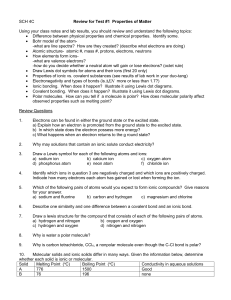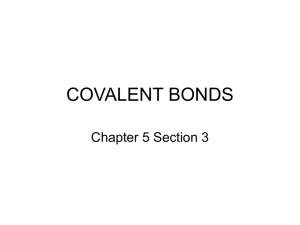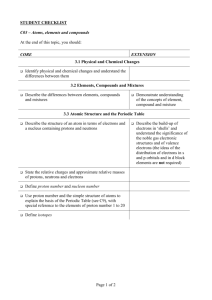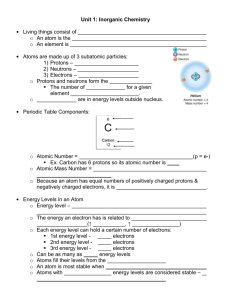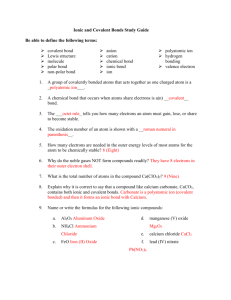Chemical Bonding Worksheet
advertisement
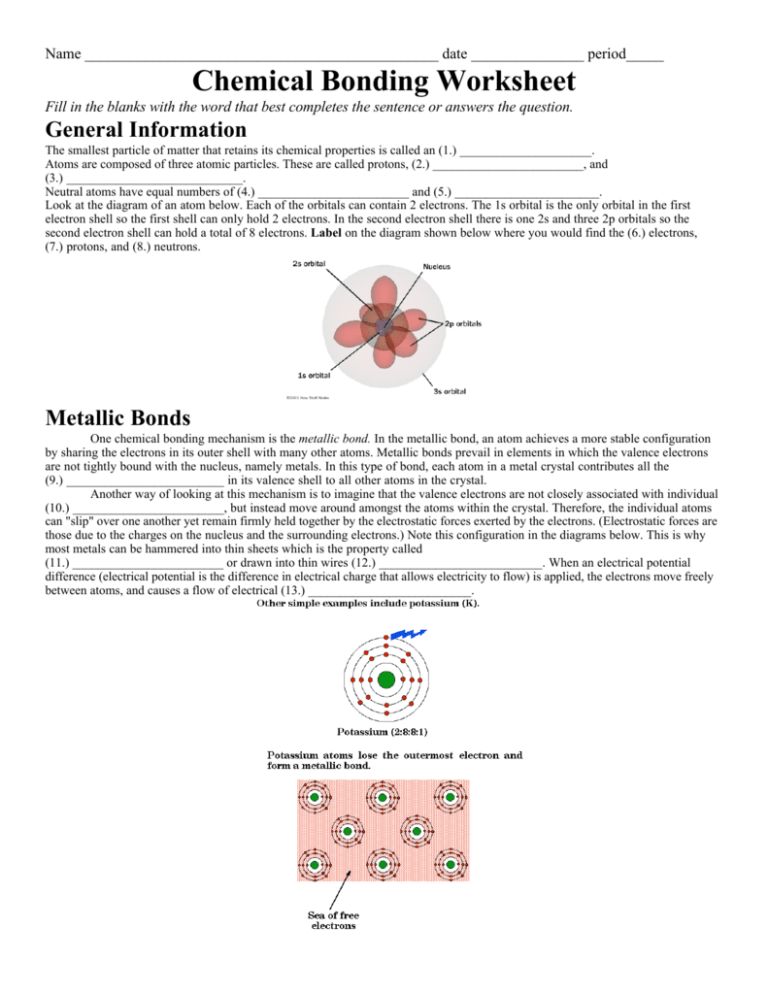
Name _______________________________________________ date _______________ period_____ Chemical Bonding Worksheet Fill in the blanks with the word that best completes the sentence or answers the question. General Information The smallest particle of matter that retains its chemical properties is called an (1.) _____________________. Atoms are composed of three atomic particles. These are called protons, (2.) ________________________, and (3.) ____________________________. Neutral atoms have equal numbers of (4.) ________________________ and (5.) _______________________. Look at the diagram of an atom below. Each of the orbitals can contain 2 electrons. The 1s orbital is the only orbital in the first electron shell so the first shell can only hold 2 electrons. In the second electron shell there is one 2s and three 2p orbitals so the second electron shell can hold a total of 8 electrons. Label on the diagram shown below where you would find the (6.) electrons, (7.) protons, and (8.) neutrons. Metallic Bonds One chemical bonding mechanism is the metallic bond. In the metallic bond, an atom achieves a more stable configuration by sharing the electrons in its outer shell with many other atoms. Metallic bonds prevail in elements in which the valence electrons are not tightly bound with the nucleus, namely metals. In this type of bond, each atom in a metal crystal contributes all the (9.) _________________________ in its valence shell to all other atoms in the crystal. Another way of looking at this mechanism is to imagine that the valence electrons are not closely associated with individual (10.) ________________________, but instead move around amongst the atoms within the crystal. Therefore, the individual atoms can "slip" over one another yet remain firmly held together by the electrostatic forces exerted by the electrons. (Electrostatic forces are those due to the charges on the nucleus and the surrounding electrons.) Note this configuration in the diagrams below. This is why most metals can be hammered into thin sheets which is the property called (11.) ________________________ or drawn into thin wires (12.) __________________________. When an electrical potential difference (electrical potential is the difference in electrical charge that allows electricity to flow) is applied, the electrons move freely between atoms, and causes a flow of electrical (13.) __________________________. Covalent Bonds vs Ionic Bonds Ionic and Covalent bonds are often compared and contrasted. Below is a diagram showing examples of each of these type of bonds. The main difference is that in covalent bonds there is a (14.) ________________________ of the electrons whereas in ionic bonds there has been a (15.) _________________________ of at least one electron to another atom. Covalent Bonds Covalent chemical bonds involve the (16.) _________________________ of a pair of valence electrons by two atoms, in contrast to the transfer of electrons in ionic bonds. Such bonds lead to stable molecules if they share electrons in such a way as to create a noble gas configuration for each atom. Hydrogen gas forms the simplest covalent bond. The halogens such as chlorine also exist as diatomic gases by forming covalent bonds. The nitrogen and oxygen which makes up the bulk of the atmosphere also exhibits covalent bonding in forming diatomic molecules. Covalent bonding can be visualized with the aid of Lewis (dot) diagrams. Lewis diagrams show only the valence electrons around the chemical symbol for an element. There is an example of a Lewis (dot) diagram below in the diagram showing a hydrogen molecule and a water molecule. Note the (17.) _________________________ electrons are the only ones shown in the dot diagrams. Drawing the Dot Structure for Hydrogen Chloride The electrons spend more time around the Chlorine atom than the Hydrogen atom making the Chlorine side of the molecule have a negative charge and the Hydrogen side of the atom have a positive charge. Polar vs Nonpolar Covalent Bonds Covalent bonds in which the sharing of the electron pair is (18.) _____________________, with the electrons spending more time around the more nonmetallic atom, are called polar covalent bonds. In such a bond there is a charge separation with one atom being slightly more positive and the other more negative. Ionic Bonds In case where one or more atoms lose electrons and other atoms gain them in order to produce a noble gas electron configuration, the bond is called an ionic bond. Some atoms, such as metals tend to (19.) __________________________ electrons to make the outside ring or rings of electrons more stable and other atoms tend to gain electrons to complete the outside ring. An (20.) ___________________________ is a charged particle. Electrons are negative. The negative charge of the electrons can be offset by the positive charge of the protons. When an atom loses electrons it becomes a (21.) ___________________________ ion because the number of protons exceeds the number of electrons. Nonmetal ions and most of the polyatomic ions have a negative charge. The nonmetal ions tend to (22.) __________________________electrons to fill out the outer shell. When the number of electrons exceeds the number of protons, the ion is negative. The attraction between a positive ion and a negative ion is an ionic bond. Any positive ion will bond with any (23.) ____________________________ ion. They are not fussy. An ionic compound is a group of atoms attached by an ionic bond that is a major unifying portion of the compound. A positive ion, whether it is a single atom or a group of atoms all with the same charge, is called a (24.) ____________________________. A negative ion is called an (25.) __________________________. The name of an ionic compound is the name of the positive ion (cation) first and the negative (anion) ion second. The names of the ions of nonmetal elements (anions) develop an -ide on the end of the name of the element. For instance, fluorine ion is fluoride, oxygen ion is (26.) _________________________, and iodine ion is (27.) __________________________. There are a number of elements, usually the (28.) __________________________ metals that having more than one valence, that have a name for each ion, for instance ferric ion is an iron ion with a positive three charge. Ferrous ion is an iron ion with a charge of plus two. There are some ion which are called polyatomic ions. These are covalently bonded groupings that act all together as ions. Examples of polyatomic ions are phosphate, cyanide, ammonium, and hydroxide. Below is a diagram of a sodium chloride crystal. Note how the ions are arranged in a regular pattern. Also note that there is a line indicating the attraction between each of the ions in each of the molecules. This attraction between molecules allows for the ionic compound to have a (29.) _____________________________ melting point. Properties of ionic compounds include that they are (30.) ___________________________ at room temperature, will (31.) _____________________________ electricity when melted or dissolved, and will not conduct electricity when in the (32.) _______________________________ form. Naming Ionic and Covalent Compounds The naming of ionic compounds is different from the naming of covalent compounds. Ionic compounds are named according to the directions in the “Math Skills” box on p. 125 of your text book. Go over these directions with your teacher. After you go through the directions, attempt the practice problems #1 - #4 on the bottom of p. 125 and write your answers below. You will need your periodic table and the polyatomic packet. It will be useful to use the ion cards to help figure out the formulas for these compounds. 1.) lithium oxide __________________________________ 3.) titanium (III) nitride is___________________________________ 2.) beryllium chloride ______________________________ 4.) cobalt (III) hydroxide is__________________________________ Now you need to think in reverse. You are given the formula and need to figure out the name of the ionic compounds for the molecules in the “Check Your Understanding” section on p. 128 of your text book. 1. a.) Ni3(PO4)2 ____________________________________ d.) CrCl2 _____________________________________________ b.) FeI2 ___________________________________________ e.) NaCN _____________________________________________ c.) MnF2 __________________________________________ f.) CuS _______________________________________________ 2. a.)You are now being given the formula for several covalent compounds. These problems are also on p. 128 of your text book. Use the prefixes related to numbers of atoms from p. 126 to name the following covalent compounds. a.) As2O5 __________________________________________ d.) P4O10 _____________________________________________ b.) SiI4 ____________________________________________ e.) SeO2 ______________________________________________ c.) P4S 3 ___________________________________________ f.) PCl3 ______________________________________________ PO4 -1 Ni +2 PO4 -1 IFe +2 I- FMn +2 F- Cr +2 Cl Cl - Na +1 CN - SCu +2 S- Li +1 O -2 Li +1 Cl -1 Be +2 Cl -1 Ti +3 N -3 OH -1 Co +3 OH -1 OH -1
